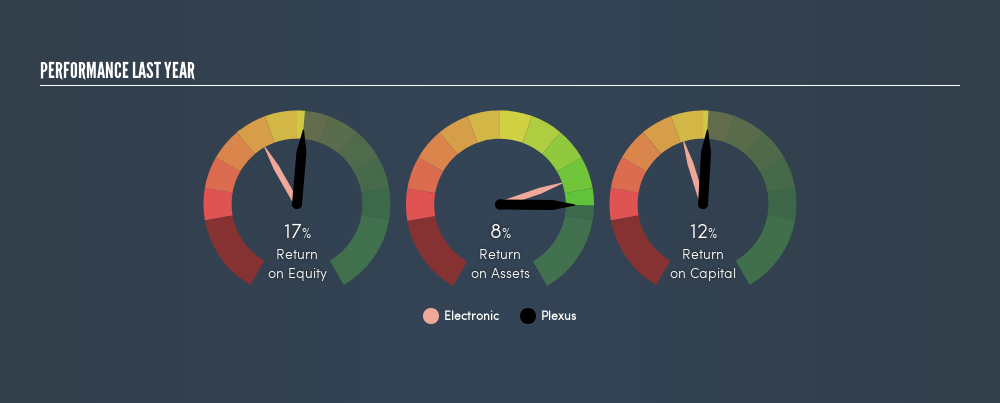- United States
- /
- Electronic Equipment and Components
- /
- NasdaqGS:PLXS
Evaluating Plexus Corp.’s (NASDAQ:PLXS) Investments In Its Business

Today we are going to look at Plexus Corp. (NASDAQ:PLXS) to see whether it might be an attractive investment prospect. In particular, we'll consider its Return On Capital Employed (ROCE), as that can give us insight into how profitably the company is able to employ capital in its business.
First up, we'll look at what ROCE is and how we calculate it. Then we'll compare its ROCE to similar companies. Last but not least, we'll look at what impact its current liabilities have on its ROCE.
Understanding Return On Capital Employed (ROCE)
ROCE measures the 'return' (pre-tax profit) a company generates from capital employed in its business. In general, businesses with a higher ROCE are usually better quality. Overall, it is a valuable metric that has its flaws. Renowned investment researcher Michael Mauboussin has suggested that a high ROCE can indicate that 'one dollar invested in the company generates value of more than one dollar'.
So, How Do We Calculate ROCE?
Analysts use this formula to calculate return on capital employed:
Return on Capital Employed = Earnings Before Interest and Tax (EBIT) ÷ (Total Assets - Current Liabilities)
Or for Plexus:
0.12 = US$142m ÷ (US$2.0b - US$876m) (Based on the trailing twelve months to June 2019.)
So, Plexus has an ROCE of 12%.
See our latest analysis for Plexus
Is Plexus's ROCE Good?
One way to assess ROCE is to compare similar companies. We can see Plexus's ROCE is around the 12% average reported by the Electronic industry. Regardless of where Plexus sits next to its industry, its ROCE in absolute terms appears satisfactory, and this company could be worth a closer look.
In our analysis, Plexus's ROCE appears to be 12%, compared to 3 years ago, when its ROCE was 9.9%. This makes us think about whether the company has been reinvesting shrewdly.

It is important to remember that ROCE shows past performance, and is not necessarily predictive. Companies in cyclical industries can be difficult to understand using ROCE, as returns typically look high during boom times, and low during busts. This is because ROCE only looks at one year, instead of considering returns across a whole cycle. Future performance is what matters, and you can see analyst predictions in our free report on analyst forecasts for the company.
Plexus's Current Liabilities And Their Impact On Its ROCE
Current liabilities are short term bills and invoices that need to be paid in 12 months or less. Due to the way the ROCE equation works, having large bills due in the near term can make it look as though a company has less capital employed, and thus a higher ROCE than usual. To counteract this, we check if a company has high current liabilities, relative to its total assets.
Plexus has total liabilities of US$876m and total assets of US$2.0b. As a result, its current liabilities are equal to approximately 43% of its total assets. Plexus has a medium level of current liabilities, which would boost the ROCE.
The Bottom Line On Plexus's ROCE
Plexus's ROCE does look good, but the level of current liabilities also contribute to that. There might be better investments than Plexus out there, but you will have to work hard to find them . These promising businesses with rapidly growing earnings might be right up your alley.
If you like to buy stocks alongside management, then you might just love this free list of companies. (Hint: insiders have been buying them).
We aim to bring you long-term focused research analysis driven by fundamental data. Note that our analysis may not factor in the latest price-sensitive company announcements or qualitative material.
If you spot an error that warrants correction, please contact the editor at editorial-team@simplywallst.com. This article by Simply Wall St is general in nature. It does not constitute a recommendation to buy or sell any stock, and does not take account of your objectives, or your financial situation. Simply Wall St has no position in the stocks mentioned. Thank you for reading.
About NasdaqGS:PLXS
Plexus
Provides electronic manufacturing services in the United States and internationally.
Flawless balance sheet with solid track record.
Similar Companies
Market Insights
Community Narratives



